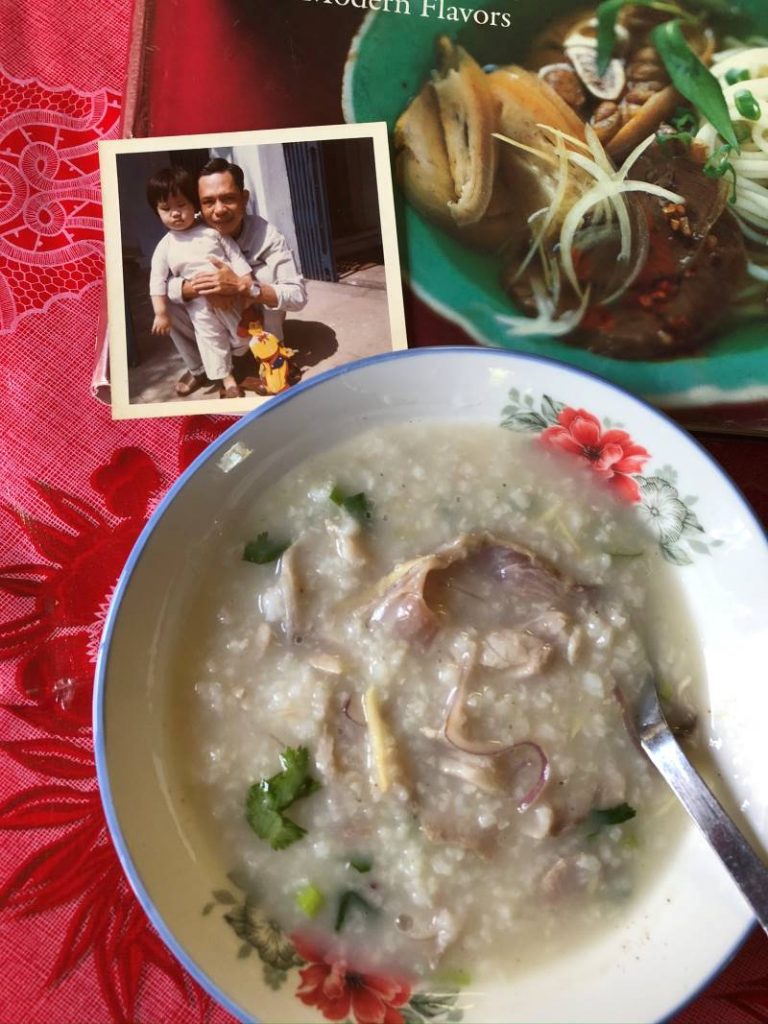
Looking back, the ambiguous trajectory of the escape seemed like several life journeys. Our family of seven abandoned our home to avoid the communist takeover of South Vietnam in April 1975. Five weeks later we resettled in a small, conservative Orange County beach town in Southern California. Having traveled from Saigon to Guam to Honolulu to arrive at Camp Pendleton Marine Base, we finally ended up in San Clemente, home of Richard Nixon—the Western White House at “La Casa Pacifica.” My Dad said, “If this place is good enough for an American president then it’s good enough for us.”
After our family arrived in America, my father had more time to spend with me than ever before. He didn’t have an office to go to anymore. He left his business consulting life behind when we fled Saigon (now Ho Chi Minh City) and became refugees. Our family in 1975, newly arrived in America!
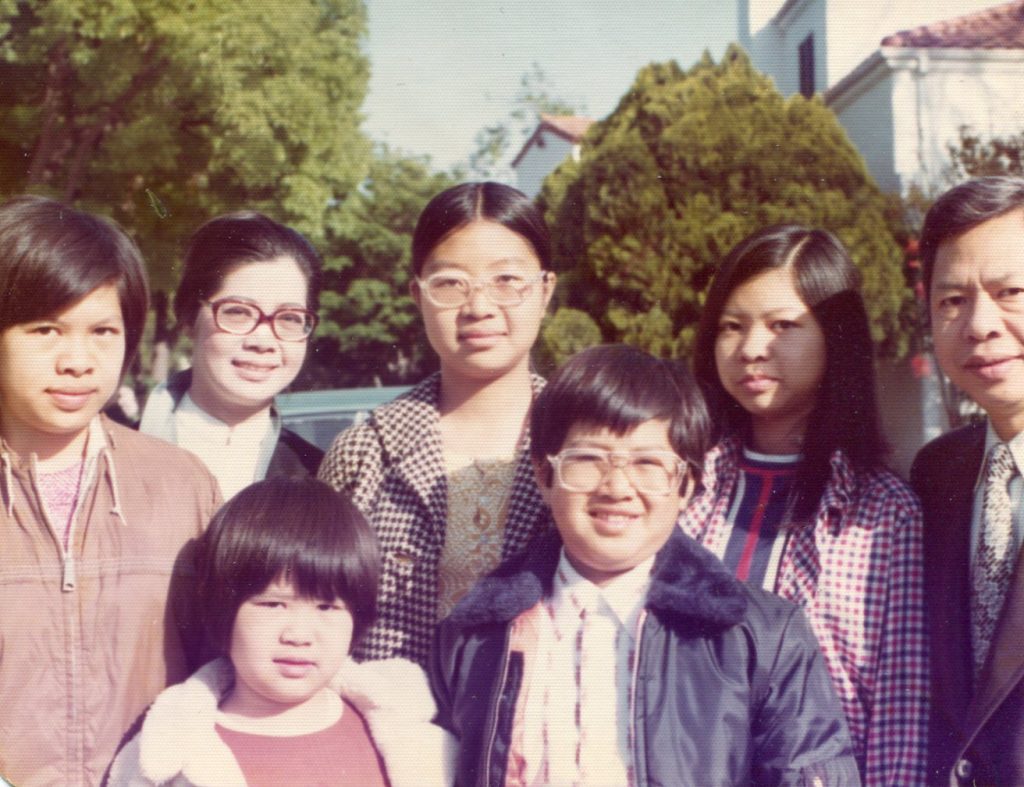
When Dad wasn’t teaching English as a second language classes at local schools, he explored Orange County. His military background (he served as a provincial governor under President Diem and resigned in 1963) plus general interest in the unfamiliar drove this quest for adventure in Southern California’s suburbia. He was out to discover America! And because my mom, older sisters and brother busied themselves with work and school, I became his designated exploration partner. As a six-year-old kid with limited English and few friends, I didn’t have much to lose when I agreed to go on those lengthy drives.
We took excursions together in our first American car, a used blue Ford Mercury Comet that my father bought for $350. Phonebooks and the PennySaver (think printed Craigslist for California communities) guided us to thrift shops and yard sales where Dad would pick up home appliances or gadgets. As we drove, he would tell me stories about living in Vietnam and philosophize about life. Because he liked to talk and I was a willing listener, this was how we bonded as father and daughter.
California Car Culture
Of course, I fondly remember trips involving food. One time, we cruised around with my dad’s friend Mr. Lee. When it got near lunchtime, Mr. Lee announced that he wanted to take us to eat at a Chinese restaurant. This was a real treat since our family, at that time, only dined out at the invitation (and expense!) of others. My parents couldn’t regularly afford to take all five kids and themselves out to eat, so “home cooked meals are better and cheaper” was their official motto.

Mr. Lee gave directions as my Dad drove. We were apparently heading for one of Mr. Lee’s favorite haunts. We drove for what seemed like forever. But then, as a child with a grumbling stomach, any distance would have seemed like an eternity. My father steered the Comet down roads that we’d never driven before.
Finally, Mr. Lee pointed to a renovated coffee shop with green and white signs and we pulled into the parking lot. I didn’t pay much attention to the decor inside because I was starving. No need to read the menu, Mr. Lee said, as he offered to do us the honor of ordering. Sure, Dad replied. The menu items were unfamiliar to us under the guises of their vague English descriptions and Chinese characters. I was so hungry that my anticipation for food could hardly be contained. Try to remain a quiet and polite kid when you’re on—what at that point seemed to be—the verge of starvation!
Then the food arrived. Wow! It was all so good. We dove into every dish -- fragrant stir fries, delicate vegetables and hot steamed rice made for a simple and satisfying repast. The most impressive one featured chunks of silky tofu and bits of ground pork, all cloaked in a velvety spicy sauce. What a great combination of intense flavors and plush textures! We ate till the plates were clean. When we got home, my father reported our day’s adventures to the family. My siblings could barely hide their jealousy. That meal was something that only my father and I had shared. As the youngest child, I suddenly felt bigger and more important than the rest.
That was my first dining experience in a Chinese restaurant. When I got my driver’s license, I repeatedly tried to retrace our path but never found the green and white signs or the renovated coffee shop. The comforting pleasures of that childhood experience kept eluding me. Later on, as I was cooking my way through Irene Kuo’s classic The Key to Chinese Cooking, I realized that I’d fallen for mapo dofu. Years later, I ventured to Chengdu in China to taste the real deal and to create my own recipe for my Asian Tofu cookbook, which I've shared here.
Franco-Viet-American Bakery Noshes
Another memorable excursion occurred a few years later when Dad and I went to National Lumber, a now-defunct chain of home building supplies stores whose mascot was a cartoon character named Cheap Chicken. Leaving that store in the nearby town of El Toro, we spotted a new, modest French bakery. Curious, we stepped inside.
The baked goods and smells from this non-descript little bakery immediately sent us back to Saigon. Behind the counter were Asians who turned out to be Vietnamese people who’d learned their trade through years of living as migrant workers in New Caledonia, a French colony located east of Australia. “Hey,” Dad said to me in a hushed tone, “they lived in a French colony too. Their stuff must not be that bad. Let’s try a few things.”
We bought two baguettes for the family and then my Dad chose a napoleon for himself and I selected an éclair. I got to carry the loaves to the car and noticed the incredible yeasty, sweet smell that they exuded. The slashes on the golden brown baguettes were perfectly executed, making the bread resemble boldly flexed biceps. The loaves were crisp and substantial in weight and feel. This was serious bread, I thought to myself as I held it protectively.
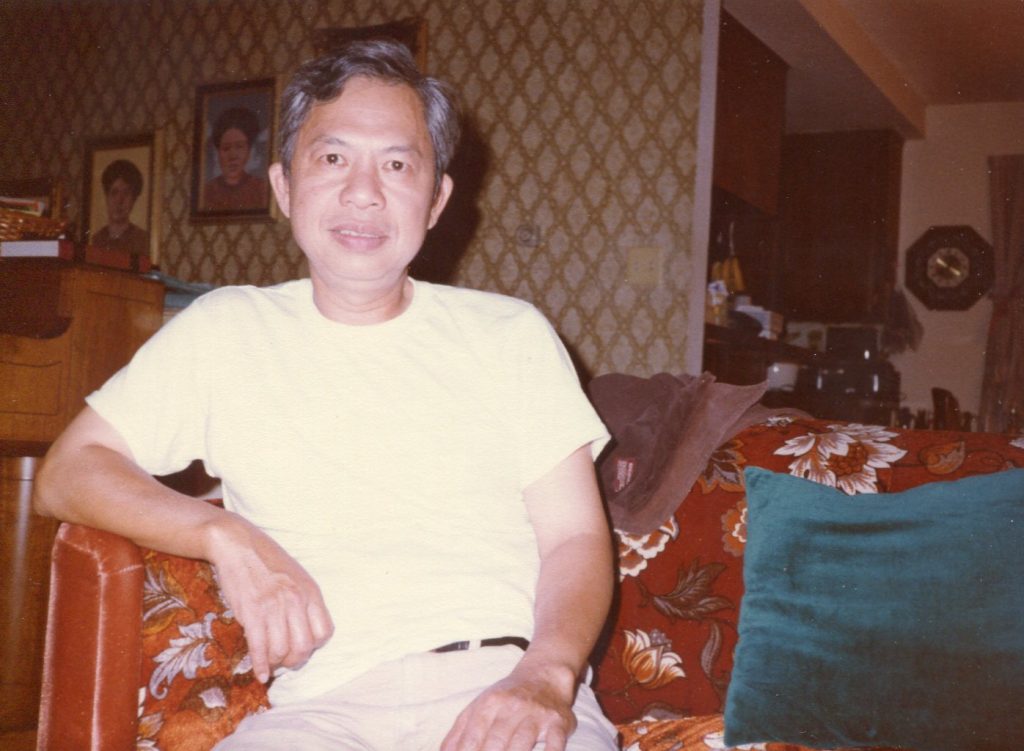
Back in the car, we tucked into our respective pastries, switching off occasionally for comparison taste tests. My éclair was pretty good but the napoleon was outstanding – crisp buttery layers of puff pastry filled with rich pastry cream that were unlike plebeian versions of tasteless chew pastry and vanilla pudding.
As usual, Dad reported our latest discovery to the family, conveniently leaving out the luscious details about the napoleon and éclair. Everyone tore into the baguettes, discussing their merits. The bakery received a unanimous ‘thumbs up’ from that Nguyen tasting. The substantive bread was more like the best baked ones in Saigon, we all agreed. They were flavorful from the delicate crust to the chewy spongy crumb. They were superior to the cheap, soulless baguettes sold by many Little Saigon bakeries.
For several years, we’d drive 30 minutes for baguette and croissants from the New Caledonian-Viet-American bakers. One day, the bakery changed hands. The new Viet-American owners lowered the prices and lowered the quality too. Decades later I recalled that bakery’s original bread when I formulated by banh mi roll recipe for The Banh Mi Handbook.
Teenage Pivot
My exploits with Dad tapered off when I got to high school and found myself too ‘busy’ with school, part-time jobs, and friends. Hanging around with your father was not a cool or happening pastime. Then I went off to college and came home only on weekends or during summer vacation to hang out with high school friends. My relationship with my father changed because I was no longer his exploring buddy, and our commonalities weakened and unraveled.
When we rode in the car together, he’d tell me how I should run my life and I would block out his voice by daydreaming. There wasn’t any adventure left for us since we’d explored most of the nooks and crannies in the area. Plus, Orange County’s suburban, homogeneous landscape paled in comparison to L.A.’s wild urban sprawl. Even food couldn’t be the bonding element anymore because my father was watching his cholesterol and salt intake. How much fun can non-fat, low-fat or low-sodium food be?
Below is my sister on the left and dissaffected me on the right. My parents are looking much happier than their kids!
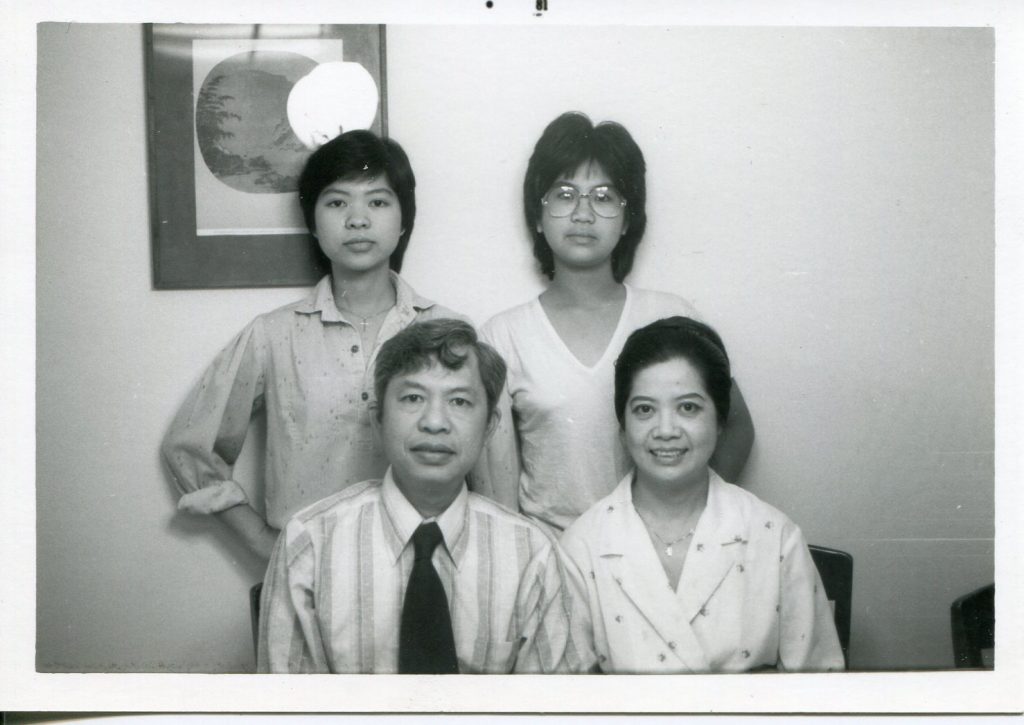
I was trying to become an independent adult and wanted to leave my childhood behind me. Yet, redefining my relationship with my Dad was an arduous task that I didn’t want to tackle. It wasn’t long before this impasse left me hungry for the simple childhood pleasures of riding in the Comet, doing the rounds at the thrift shops and sharing secret meals. However, like the devolution of that French bakery, the vicissitudes of time had introduced changes that prohibited me from going back. (My father had even given away the Comet to a Vietnamese priest who was a longtime family friend!) I had to figure out a way to negotiate the complexities of being an adult.
Soup and Salad Session
One day in the early 1990s, my mom decided to take a rare trip to Oregon to see a girlfriend. Dad couldn’t leave his landscaping business so he remained at home. This was the first time that they had been separated since we came to the United States. I think that they were both excited yet uncertain about the prospect of being apart for a while. Before my mother had even left for Portland, I started to feel a little sorry for my poor Bố Già (“Old Daddy”) What was he going to do in that big house? More importantly, what was he going to eat? (Below is a photo of my parents around 1990.)
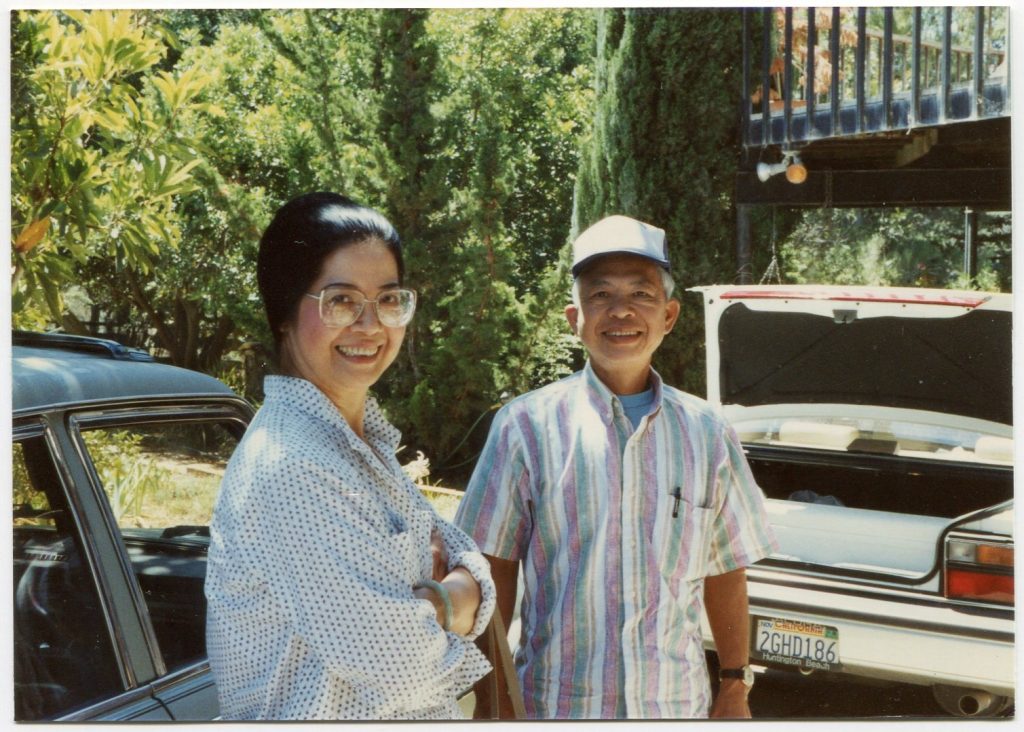
Out of guilt and concern, I called my father and told him I’d come home to spend the weekend. I wanted to do something out of the ordinary for him and remembered a recent conversation that we had had about a Vietnamese salad made from the bud of banana trees. Dad seemed rather passionate about the dish, telling me which specific herb had to be eaten with the salad. Mom, on the other hand, didn’t like it whatsoever. She’d eaten a lot of weird stuff in her life and enjoyed most of it except for a few things like astringent banana bud salad. She was clear about not letting it enter her repertoire of favored recipes. As a treat for my father, I decided to make the salad and searched out the best banana bud I could find and a newly opened mega 99 Ranch market.
At first, Dad feigned mild surprise, but then launched into a detailed set of instructions on how to prepare the banana bud. As an obedient daughter who saw his genuine enthusiasm, of course I acquiesced and followed his orders.
Dad also proposed that we make cháo cá, a creamy rice porridge soup (think Chinese congee/jook) with marinated sea bass to complement the salad. He’d been thinking about that dish, he said. The dish called for marinating raw fish with onion and ginger and then pouring on the hot soup right before serving to cook the fish. My mother, rigidly committed to food hygiene, ‘protected’ our family by never letting us eat raw or partially cooked food.
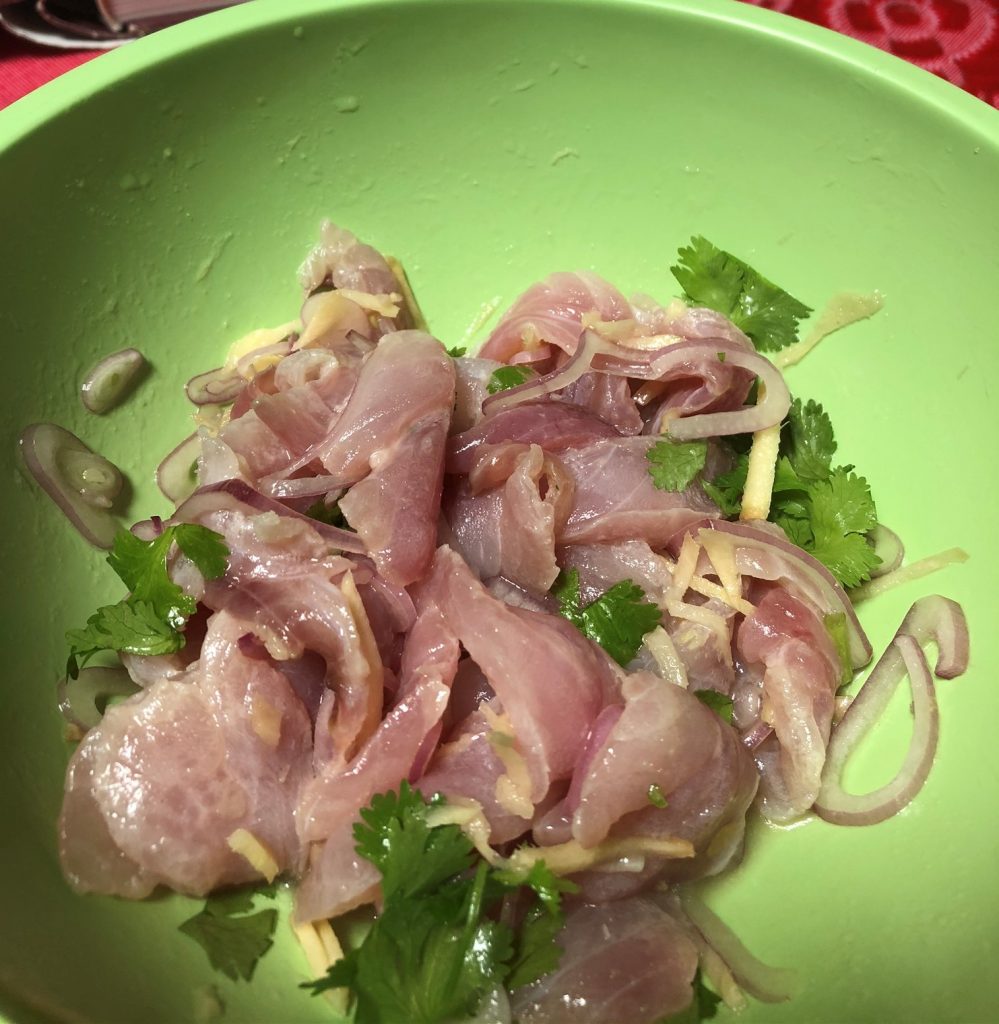
Given that background, I knew that Dad liked the idea that while Mom was away, we’d eat things that she normally wouldn’t make. In short, we were cooking and once again eating on the sly. My father and I spent a good few hours cooking and talking. As he sat at the kitchen counter telling me what to do, I prepped and cooked the ingredients accordingly, adding a few of my own touches here and there.
We set the table and dug in. The crunchy, nutty tangle of salad proved to be a delightful contrast to the creamy, rich porridge. Dad opened a few beers to round out the meal. There wasn’t much talk between the two of us as we ate—a surefire sign that both body and soul were being nourished. The next morning I came down to the kitchen and found my father slurping away at the leftover soup. He must have had a good time revisiting our food adventures from times past.
Since then, we haven’t shared another evening like that again. Nowadays, when my husband and I come home to visit my parents, we all spend a lot of time talking about food, culture and eating. My brother, Dan, snapped this photo of my dad earlier this year.
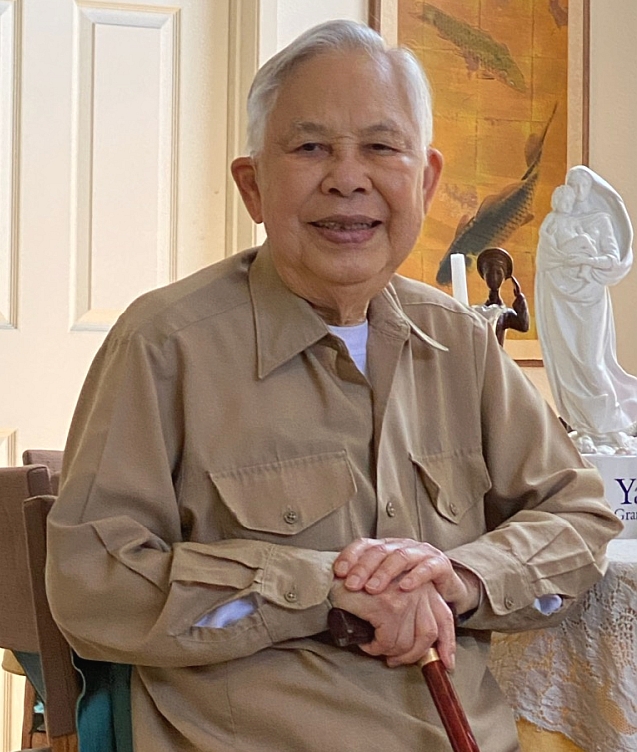
Our lively conversations and full stomachs have more than filled the void that I had felt before. It’s comforting to know that the seeds of childhood pleasures can be saved, replanted and nurtured for adult consumption.
I included the salad and soup recipes in my first book, Into the Vietnamese Kitchen. I recently updated the soup recipe to post on this site.
Gingery Marinated Fish Rice Porridge
Ingredients
- ⅔ cup long-grain or short-grain white rice
- 8 cups lightly salted chicken stock, or 6 cups lightly salted chicken broth plus 2 cups water
- 4 slices of ginger each about ⅛ inch thick, the size of a quarter, smacked
- 2 green onions, white parts only (save the green part for garnishing the soup)
- 12 ounces fresh white fish fillet, such as rockfish, sea bass, sole, cod or baramundi
- ⅓ cup thinly sliced shallot, or ½ cup thinly sliced red onion
- Chubby 1-inch section ginger, peeled and cut into fine matchsticks
- 2 tablespoons chopped cilantro
- 2 ½ tablespoons apple cider vinegar or unseasoned rice vinegar
- 2 tablespoons fish sauce
- 1 tablespoon canola or other neutral oil
- ½ teaspoon sugar
- ¼ teaspoon fine sea salt
- ¼ cup thinly sliced green onion, green parts only
- Freshly ground black pepper, for garnish
Instructions
- Put the rice in a heavy-bottom saucepan and fill it with water to cover by 1 inch. Stir the rice with your hand 8 to10 times around and then carefully pour out the milky water. Add the stock, ginger, and green onion. Bring the mixture to a boil over high heat. Reduce the heat to medium-low and partially cover the pan. The rice should be gently bouncing in the bubbling water.
- After 5 minutes, stir the rice and reduce the heat to low. Make sure the porridge simmers softly and does not boil over, or you will lose the precious starch that makes it creamy. Continue cooking, partially covered for about 1 hour, or until the rice has broken down and becomes suspended in the soup. The porridge will be creamy white with little separation between rice and liquid. Discard the ginger and green onion. The porridge may be made a day in advance and reheated over a low flame with a bit of water to prevent scorching. It may thicken considerably after cooling but so add water to thin it out.
- While the porridge cooks (or slowly reheats if you made it ahead of time), marinate the fish. Thinly slice the fish at a 45-degree angle into pieces about ⅛ inch thick, 1 by 2 inches long. Rinse the shallot under running water for about 10 seconds, then drain well. In a bowl, combine the fish, shallot, ginger, cilantro vinegar, fish sauce, oil, sugar, and salt. Use your hands or a spatula to mix gently. Cover and let marinate for 30 minutes at room temperature; the fish will turn slightly opaque. The fish may be refrigerated up to 8 hours but should sit at room temperature for 20 minutes before using.
- Divide the marinated fish among the soup bowls. Bring the porridge to a boil over medium heat, stirring occasionally to prevent scorching. Ladle the hot soup over the fish. Garnish green onion and black pepper. Stir up the fish to finish its cooking and blend flavors before eating.













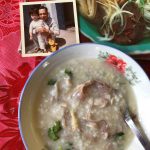




nathalia says
Bonjour depuis la France ! Merci pour avoir partagé ses merveilleux souvenirs, il y a beaucoup d'émotions à travers tes mots .....Merci encore !
J'aurais une question, envisages-tu de traduire ton livre en français ?
Belle journée et au plaisir de te lire
Andrea Nguyen says
Sorry, I don't speak/read French well. Welcome and thank you for visiting.
MICHAEL QUINN says
She wants to know if you will ever have your book published in French! She loves your memories!
Andrea Nguyen says
I'd love to but deals like that are done between a French publisher and my publisher. I've had the Pho Cookbook translated into German! Thanks for asking!
Betty Weiss says
Does this recipe make four servings?
Andrea Nguyen says
Yes. Sorry for that. I just updated the recipe. Thanks for watching my back!
Erica says
Hi Andrea, I just discovered your cookbook Vietnamese Food Any Day and now your blog. I have been immediately enraptured by your storytelling and loving descriptions of food. Thank you for transporting me during these lockdown days. I look forward to trying your recipes soon. Thank you, be well!
Andrea Nguyen says
Thank you, Erica. You made my day. All the best to you and your loved ones.
Von Griffing says
I love all your posts about your dad because he reminds me of my dad who had past away 20 years ago. This particular post is especially touching to me because my dad and I went on thrift store and food adventures also when I was 10 until I became a teenager. The pictures that go with your narrative are precious. Recently bought your Vietnamese Food Any Day book, the caramelize shrimp recipe is on my regular rotation for dinner. I live about 45 minutes from San Clemente now, it's a lovely beach town. Would be great if I happen to run into your dad when I visit the town. I will tell him I'm a fan of you and him.
Andrea Nguyen says
Von! What a wonderful story for you to share. Thank you.
And, you're cooking with VFAD. That shrimp recipe is so darn good. I would eat the shrimp without rice when I was developing the recipe.
Greatly appreciate your reading this post and adding your experience. Thrift stores with dads is a fantastic combo!
Beckie says
Beautiful story. Thanks for sharing😊
Andrea Nguyen says
Thank you, Beckie!